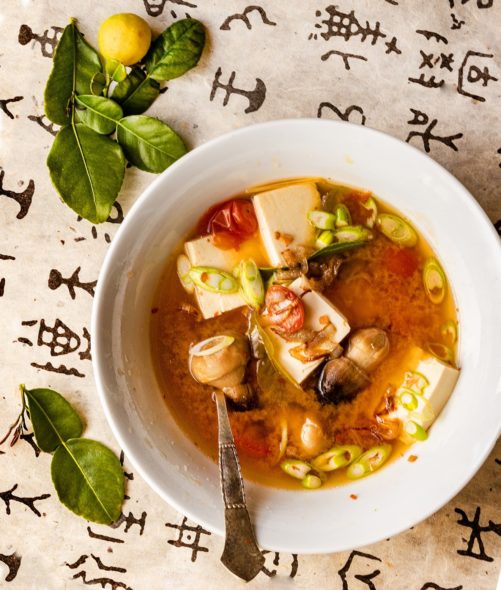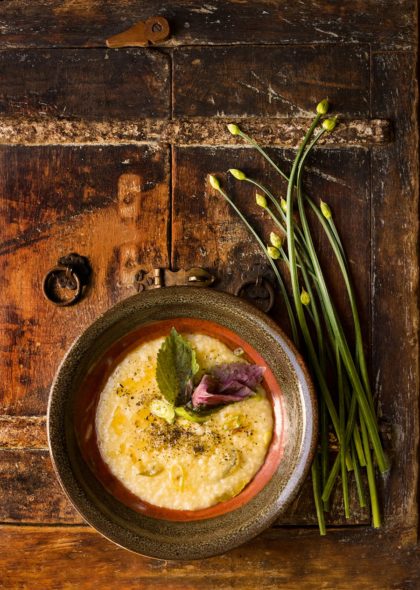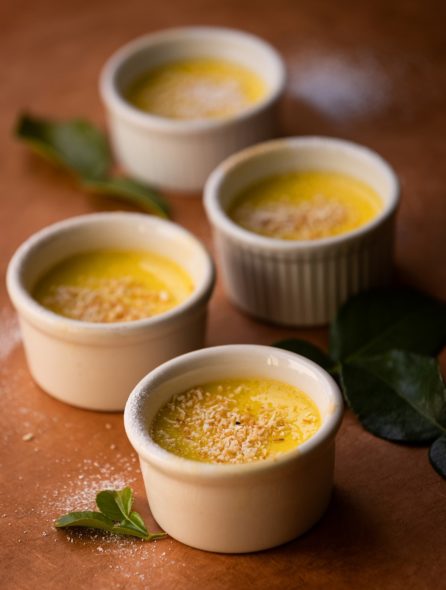Kaffir lime leaves (also spelled Kieffer) are used extensively in Southeast Asian cooking where they lend the most wonderful and pungent citrus perfume and flavor to all manner of dishes including soups, curries and sauces. Known in Thailand as Magroot or Makrut, the Kaffir lime tree also bears a small, warty skinned fruit which is not as culinarily important as the leaves because there aren’t as many of them available as the leaves and they yield very little juice. The grated rind can also be used but it tends to be a little bitter.
While the name “kaffir lime” has widespread acceptance, it’s important to note that the term is sometimes considered offensive in certain parts of the world. The word “kaffir” derives from the equally offensive Arabic word “kapiri.” In Sri Lanka, the word had been used for hundreds of years as a racial slur and is still considered offensive around South Africa. Despite its connotations, kaffir lime is the common term used worldwide, even in South Africa. However, many chefs and foodies are shifting to more politically correct alternative names such as the Thai or makrut lime.
In Southeast Asia the leaves are generally used in the same way that bay leaves are used in Mediterranean cooking; that is whole ones are added for flavor and are generally not eaten but discarded from the dish after they’ve perfumed it. They are tough in texture like a bay leaf. Sometimes though the leaves are eaten after finely chopping or slicing. Recipes will call for slivering them very, very finely with a knife or scissors. These fine slivers are added to dishes, usually at the last minute to get maximum fragrance and flavor impact.
If you can find the fruit, treat it like regular limes and grate the skin and squeeze the juice to extract its flavor. Kaffir lime can be grown wherever citrus is grown especially in moist, subtropical areas like California, Texas and Florida. As a result, it’s available in Asian markets and occasionally in gourmet/natural foods markets. You’ll sometimes find the leaves available dried but don’t buy them – – they are mere shadows of their fresh cousins. You can also find them frozen and they can be pretty good if they haven’t been in the freezer case too long.
Kaffir lime trees require lots of light (up to 12 hours a day) and don’t tolerate cold very well. They are sub-tropical plants. I have a couple of trees where I live in Northern California that I grow in big pots with wheels. This enables me to move them around and protect them from the frosts that we get in Sonoma County. If you live in a citrus growing area, you can order trees from your local nursery. Up until the last few years they were embargoed and nearly impossible to get because of concerns about disease and pests.
Over the years I’ve found all kinds of interesting uses for the leaves including adding to olive oil to perfume it, adding a crushed leaf when you brew hot tea and – – if my Grandmother were still with us – – she’d slip a leaf or two into her sock or underwear drawer to subtly scent those garments!
SPICY TOMATO AND LIME LEAF BROTH
Makes about 2-1/2 quarts
This is a base for all kind of additions from noodles to fish and shellfish, vegetables, grilled meats, etc. I often add hot pepper sesame oil to the finished stock when I use it.
2 medium onions, peeled and coarsely chopped
9 cups chicken or vegetable stock
2 tablespoon olive or peanut oil
1 – 28 ounce can crushed tomatoes with basil
6 large fresh kaffir lime leaves
1 tablespoon Asian chile garlic sauce*
3 tablespoons fish sauce or to taste*
1/4 cup rice vinegar
3 tablespoons palm or light brown sugar
Sea salt and freshly ground pepper to taste
Add the onions and a cup or so of the stock to a blender and puree. Heat the olive oil in a stockpot over moderate heat and add the onion mixture. Cook at a simmer for 6 – 8 minutes. Puree the tomatoes and add to the pot along with the remaining stock and the rest of the ingredients.
Bring to a boil then reduce heat and simmer for 10 minutes or so. Strain thru a fine mesh strainer pushing down on the solids. Discard solids. Store covered and refrigerated for up to 5 days or frozen for up to 3 months.
*Available in Asian markets

KAFFIR AND LEMON GRASS SOUP (TOM YUM)
Serves 2 to 4
This is one of the most popular dishes in Thailand. The prefix “tom yum” means “boiled together”. It is eaten all day, year-round even in hot weather. This recipe calls for tofu, but you can use any protein instead including chicken (Tom Yum Gai), shrimp (Tom Yum Goong) or seafood like calamari or mussels. Other ingredients like rice noodles, cabbage, bean sprouts can be added.
Ingredients are readily available in Asian markets. Tom yum soup bases are available in Asian markets and are ok in a pinch but working from fresh is better and not difficult. Lemon grass is available in many supermarkets. Makrut, also known as kaffir lime leaves, galangal and Thai chile paste (nam prik pao) are available at Asian markets. Galangal and makrut lime leaves are also often found in the freezer case. Do not use dried galangal or makrut.
2 tablespoons fish sauce
2 tablespoons fresh lime juice or to taste
1 tablespoon Thai red chile paste (nam prik pao) or substitute chile garlic sauce or sambal
oelek
1 stalk lemon grass, cut into 2-inch sections and crushed
6 thin slices (about 1 ounce) galangal or ginger root
6 makrut (kaffir) lime leaves, torn into small pieces or a few wide strips of lime peel
3 cups chicken or vegetable broth
6 ounces drained tofu (either firm or soft) cut into 3/4-inch cubes
3/4 cup drained straw mushrooms or sliced oyster mushrooms
8 cherry of grape tomatoes, each cut in half
1 scallion, white and light-green parts, thinly sliced on the diagonal
Cilantro and/or Thai basil leaves
Whisk the fish sauce, lime juice and chile paste together in a small bowl.
Combine the lemon grass, galangal, half the lime leaves and broth in a medium saucepan over high heat. Bring to a boil, reduce heat and simmer for 5 minutes. With a slotted spoon discard all the solids. Note: Depending on the cook these solids can be left in the soup but I prefer to discard them.
Add the tofu, mushrooms remaining lime leaves and tomatoes to the pan. Simmer for 3 or 4 minutes. Remove from the heat; stir in the fish sauce mixture, scallions, and cilantro. Serve hot.

RICE PORRIDGE OR CONGEE
Serves 4
For anyone who has traveled in China or Japan or in most of Asia for that matter, will recognize this recipe. Congee is the ultimate comfort food in Asian cuisine. Congee or Jook is generally served as the morning meal and is believed to be an important restorative. You can serve congee at any time of the day however (and you should).
The word congee derives from Tamil, and different Asian cultures have their own version of this delicious, usually savory, rice porridge. Jook is Cantonese. Other Asian countries and regions have their own. In Japan rice porridge is called Okayu. Not to be respectful but they are all kind of the same thing. What differentiates them is the amount of stock/water that the rice is cooked with. Compared to other countries’ rice porridge, Okayu is much thicker due to the water-to-rice ratio of 1-to-5. Cantonese-style congee is 1-to-10 or more.
Big bowls of this are dished up and then all manner of additions are close by to add at the diners discretion including soy sauce, chopped green onions, cilantro leaves, finely shredded cabbage, sliced green onions, crisp fried slices of shallot, roasted peanuts, Chinese (Sichuan) pickled vegetables, pickled ginger, poached or roasted chicken and duck or other meats including cooked and dried shrimp or scallops, shiitake mushrooms, a poached egg and on and on depending on your preference. In Japan pickled vegetables are often part of the mix. It’s great and comforting anytime. Don’t you want some now?
A basic recipe:
1-1/2 quarts or so chicken stock or water
1/2 cup long grain or broken jasmine rice
3 half dollar size coin of fresh ginger
6 large kaffir lime leaves, bruised
Salt and freshly ground white pepper to taste
Add the stock to a deep saucepan and bring to a boil. Rinse the rice 2 or 3 times in cold water to remove starch and then stir into the stock along with the ginger and kaffir leaves. Bring back to the boil then reduce the heat to a simmer, cover and gently simmer for 1-1/2 hours* or until rice is very soft, porridge like and almost smooth. You can adjust cooking time to create texture you like. Stir occasionally and add stock or water to prevent rice from sticking to the bottom. Off heat and serve with additions of your choice. Thin if desired with additional stock.
*Chinese tradition calls for three hours–during which time the soup gets “ricier” in taste, thicker in texture, and, according to Chinese medicine, is easiest to digest because three hours bring the yin and yang into harmony.
KAFFIR LIME AND COCONUT SOUP WITH MUSHROOMS
Serves 4 – 6
You can add whatever other ingredients you want to this soup. Among my favorite additions are fresh cooked crab at the last minute, sautéed mushrooms (I love Nameko if you can find them but Shiitake are also tasty and readily available), properly cooked shrimp and/or crisp cooked vegetables such as sugar snap peas in place of the corn.
Anything could be added to this soup including tofu, shrimps or other fishes, grilled thinly sliced meats and more.
4 ounces thin rice vermicelli noodles
4 tablespoons vegetable oil
6 ounces oyster or shiitake mushrooms
2 cups sliced white onion (1 medium)
1 – 2 tablespoons yellow or green curry paste
5 cups chicken or vegetable stock
2 cups or so stirred coconut milk
3 large kaffir lime leaves, bruised
2 tablespoons fish sauce or to taste
2 teaspoons chile garlic sauce or to taste
1 tablespoon palm or brown sugar or to taste
1/4 cup fresh lime juice
3 cups gently packed baby spinach leaves
1/4 cup scallions cut on the bias
Thai basil and/or cilantro sprigs
Soak the rice noodles in hot water for at least 15 minutes in a bowl. Meanwhile heat half the oil in a deep soup pot and sauté the mushrooms until lightly browned. Remove and set aside.
Add remaining oil and sauté the onions until softened but not brown. Add the curry paste and cook for another minute and then add stock, coconut milk, lime leaves, fish sauce, chile garlic sauce and sugar and bring to a simmer. Stir in lime juice and reserved mushrooms and adjust the sweet/hot/sour/salty elements to your taste.
To serve: Drain the noodles and divide among deep bowls along with the spinach leaves. Ladle the hot soup over and top with scallions, Thai basil and/or cilantro sprigs.
SHRIMP WITH GREEN CURRY SAUCE
Serves 4
This recipe takes advantage of off-the shelf Thai curry paste, of which there are many entries. Look for them in Asian markets or on-line. You can use this same recipe approach for all kinds of fish, chicken or pork.
2 cups coconut milk, well stirred
1 tablespoon or so green curry paste
4 kaffir lime leaves or 2 tablespoons finely grated lime zest
1 tablespoon Asian fish sauce
1 tablespoon of brown or palm sugar
1 cup lightly packed chopped fresh spinach or green romaine lettuce leaves
Fresh lime juice
3 tablespoons olive oil
1 medium white onion, peeled and thinly sliced
1 large red or yellow bell pepper, stemmed, seeded and thinly sliced
2 tablespoons finely slivered, peeled ginger or galangal
1 tablespoon peeled and finely slivered garlic
1-1/4 pounds peeled, deveined medium shrimp (21-25 size)
1 cup diced and seeded fresh tomato
1/2 cup fresh, tender basil, mint or cilantro leaves
Steamed aromatic rice such as jasmine to accompany
Add the coconut milk, curry paste and lime leaves to a boil in a saucepan. Whisk the mixture to dissolve the paste. Simmer for 5 minutes or until sauce is lightly thickened. Discard the lime leaves if using and stir in the fish sauce, sugar and spinach. Place in a blender and puree. Adjust the hot/salt/sweet/tart elements to your taste with additional curry, fish sauce, sugar and drops of lime juice. Set aside.
In a sauté pan or wok heat 2 tablespoons of the oil and quickly sauté the onions, peppers, ginger and garlic until lightly colored and crisp-tender. Add vegetables to the curry sauce. Add the remaining tablespoon of oil to the pan and sauté the shrimps over high heat until just done. Add the curry sauce and vegetables to the pan and heat the mixture through. Stir in the tomato and the basil leaves and serve with steamed rice.
GREEN CURRY CHICKEN
Serves 3 or 4
A very easy green curry with chicken in rich coconut curry sauce.
1 1/2 tablespoons oil
2 tablespoons green curry paste, Mae Ploy brand preferred
12 ounces boneless, skinless chicken thighs cut into bite-sized pieces
1/2 cup coconut milk, well stirred
1/2 cup water
4 ounces bamboo shoots
5 kaffir lime leaves, lightly bruised
2 thin red chilies cut into thin rounds
1 tablespoon fish sauce
1 tablespoon sugar or palm sugar preferred
1/4 cup gently packed Thai basil leaves
Steamed Jasmine rice for serving
Heat a pot over medium heat and add the oil. Sauté the green curry paste until aromatic, a minute or two. Add the chicken and stir to combine well with the curry paste. Add the coconut milk and water and bring it to a quick boil.
Add the bamboo shoots, kaffir lime leaves, and red chilies. Lower the heat to simmer, cover the pot and let simmer for 10 minutes or until the curry thickens slightly and chicken is cooked through. Serve with rice.
Stir in the fish sauce, sugar, and basil leaves. Turn off the heat and serve immediately with steamed rice.
KAFFIR LIME LEAF LEMONADE
Makes enough for 4 but can be doubled
2 cups of water
12 or more large kaffir lime leaves
1 cup pure cane sugar
1/2 cup lemon juice or to taste
2 cups club soda
Combine water, leaves, and sugar in a saucepan over medium heat. Bring to a boil, lower temperature, and let the mixture simmer for about 10 minutes. Set aside to cool.
Once the mixture is chilled, pour it into a large pitcher. Add the lemon juice and club soda. Stir and serve over ice.

COCONUT AND KAFFIR LIME CRÈME CUSTARDS
6 servings
You can treat these as a brûlée and caramelize the tops with sugar if you want. I prefer this with toasted coconut as a topping but have given you both approaches.
1 19-ounce well stirred coconut milk
5 large kaffir lime leaves, finely slivered
1 teaspoon dark rum
5 egg yolks
1/3 cup granulated sugar
2/3 cup shredded coconut
Powdered sugar
Preheat oven to 325° F. Combine the coconut milk, slivered lime leaves and rum in a saucepan over medium heat. Bring just to a simmer. Remove from heat and let rest till cooled.
Separately whisk the egg yolks and the sugar in a medium bowl until pale and creamy. Over moderate heat gradually add the egg yolk mixture, stirring well after each addition. Cook until custard is steaming. Strain custard thru a fine mesh strainer and discard solids. Divide the custard evenly among six 2/3-cup ramekins.
Line the base of a roasting pan with a tea towel, folding to fit. Place ramekins on the tea towel in the pan. Carefully pour enough boiling water into the pan to come halfway up the side of the ramekins. Bake for 35-40 minutes or until custard is gently set. Remove ramekins from pan. Set aside for 15 minutes to cool. Place in the fridge for at least 2 hours to chill.
Add the coconut to a dry sauté pan and toast for a couple of minutes, stirring, until lightly golden brown. At serving time, sprinkle on top of custards and finish with a light dusting of powdered sugar.
Alternately preheat broiler on high. Divide and sprinkle 1/2 cup sugar evenly over the tops of the custards. Place under grill for a minute or so or until the sugar caramelizes. You can also use a kitchen blowtorch to caramelize the sugar.
John Ash © 2023 PD




